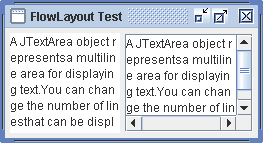
import java.awt.Dimension;
import java.awt.FlowLayout;
import javax.swing.JFrame;
import javax.swing.JScrollPane;
import javax.swing.JTextArea;
public class FlowLayoutTest {
public static void main(String[] args) {
JFrame.setDefaultLookAndFeelDecorated(true);
JFrame frame = new JFrame("FlowLayout Test");
frame.setLayout(new FlowLayout());
frame.setDefaultCloseOperation(JFrame.EXIT_ON_CLOSE);
String text = "A JTextArea object represents" + "a multiline area for displaying text."
+ "You can change the number of lines" + "that can be displayed at a time.";
JTextArea textArea1 = new JTextArea(text, 5, 10);
textArea1.setPreferredSize(new Dimension(100, 100));
JTextArea textArea2 = new JTextArea(text, 5, 10);
textArea2.setPreferredSize(new Dimension(100, 100));
JScrollPane scrollPane = new JScrollPane(textArea2, JScrollPane.VERTICAL_SCROLLBAR_ALWAYS,
JScrollPane.HORIZONTAL_SCROLLBAR_ALWAYS);
textArea1.setLineWrap(true);
textArea2.setLineWrap(true);
frame.add(textArea1);
frame.add(scrollPane);
frame.pack();
frame.setVisible(true);
}
}